Hygrocybe splendidissima (P.D. Orton) M.M. Moser - Splendid Waxcap
Phylum: Basidiomycota - Class: Agaricomycetes - Order: Agaricales - Family: Hygrophoraceae
Distribution - Taxonomic History - Etymology - Identification - Culinary Notes - Reference Sources
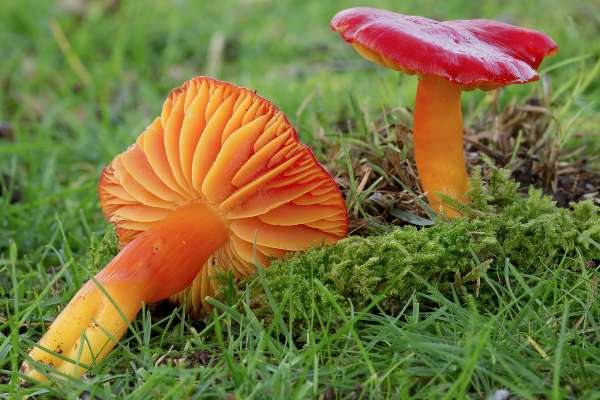
Taxonomy
One of the most often-misidentified of all the waxcaps, the Splendid Waxcap can be distinguished from the Crimson Waxcap, Hygrocybe punicea, by its dry cap and the smell of honey that is given off when the fruitbodies are dried… but how can you make use of that character is a non-destructive way? Hygrocybe splendidissima usually has a twisted stem that is slightly or markedly flattened , particularly near to the base, whereas the stem of Hygrocybe punicea is more or less round.
Several of the specimens shown on this page were photographed in Waun Las National Nature Reserve, at the National Botanic Garden of Wales, Llanarthne, Carmarthenshire.
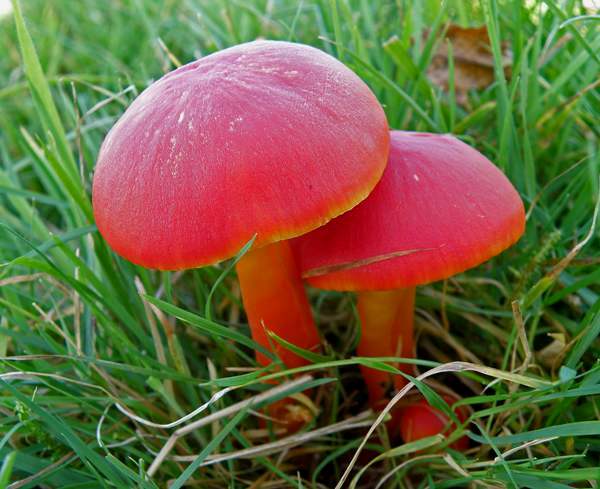
Distribution
The Splendid Waxcap is a rare find in most parts of Britain and Ireland, but there are several damp grassland and moorland sites in West Wales, in northern England, and in Scotland where it is relatively common. This is a gregarious mushroom and usually occurs in small groups, apparently jostling for space, rather than singly.
Taxonomic history
British mycologist Peter Darbishire Orton (1916 - 2006) described this waxcap in 1960, giving it the scientific name Hygrophorus splendidissimus. Its currently accepted scientific name appeared in 1967, when the Austrian mycologist Meinhard Michael Moser (1924 - 2002) transferred the Splendid Waxcap to the genmus Hygrocybe, thereby renaming it Hygrocybe splendidissima. (Some authorities consider this mushroom to be merely a form of the Scarlet Waxcap H. punicea.)
Synonyms of Hygrocybe splendidissima include Hygrophorus splendidissimus P.D. Orton, Hygrocybe punicea f. splendidissima (P.D. Orton) D.A. Reid, and Hygrocybe punicea var. splendidissima (P.D. Orton) Krieglst.
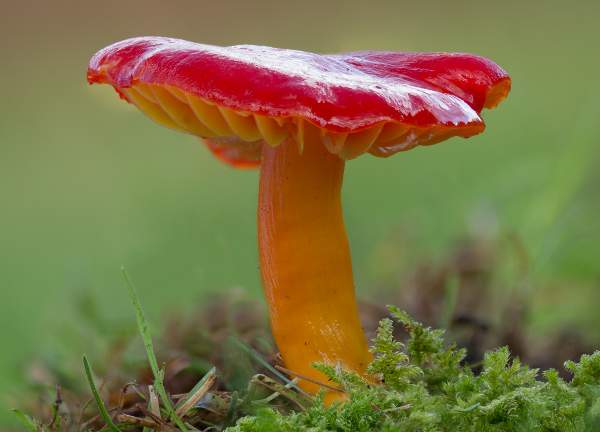
Etymology
The genus Hygrocybe is so named because fungi in this group are always very moist. Hygrocybe means 'watery head'. Superlatives are rarely used to describe fungi, but in this instance there is justification: splendidissima means 'most splendid', and it is had to imagine a more splendid sight than a group of these big bold red mushrooms gleaming in the autumn sunlight.
Identification guide
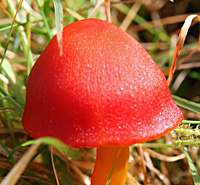 |
Cap5 to 10cm across; initially conical, becoming shallowly convex or flattening, usually with a broad umbo; scarlet; smooth; dry or only very slightly greasy. |
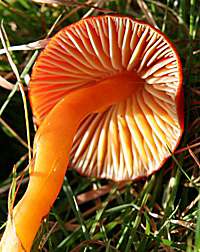 |
GillsAdnate; distant; colour as cap but usually somewhat paler. Stem7 to 10cm long and 1 to 2cm dia.; yellow flushed with cap colour, but paler near base; irregularly flattened and longitudinally grooved, narrowing near base; smooth; no ring. |
SporesEllipsoidal, smooth, 8-9.5 x 5-6µm; inamyloid. Spore printWhite. |
|
Odour/taste |
Not distinctive. |
Habitat & Ecological role |
Closely cropped or mown grassland where artificial fertilisers are not spread. This species is rare in southern Britain and Ireland but more common in Scotland. Waxcaps have long been considered to be saprobic on the dead roots of grasses and other grassland plants, but it is now considered likely that there is some kind of mutual relationship between waxcaps and mosses. |
Season |
August to November in Britain and Ireland. |
Similar species |
Hygrocybe punicea is typically a deeper red when young but its cap fades patchily to buff; it has a more cylindrical fibrous stem that is rarely twisted. (In the past the Splendid Waxcap was considered to be merely a form of Hygrocybe punicea, but they are now generally accepted as separate species because of the significant macroscopic and microscopic character differences between these two species and ongoing DNA study of waxcaps. Hygrocybe coccinea is smaller, a paler red, and has a less fibrous reddish stem. Hygrocybe conica has a more pointed cap and yellow stem flesh;it turns black with age or when cut. |
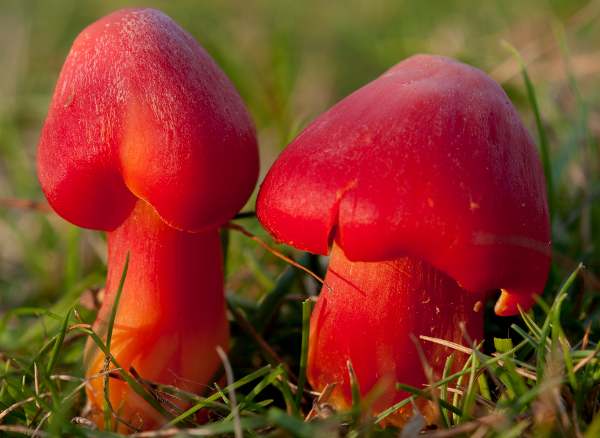
Culinary Notes
The Splendid Waxcap is reported to be edible, but because of its rarity (if not its stunning beauty, which other people might enjoy seeing) it should not be collected other than for research purposes.
Reference Sources
Fascinated by Fungi, 2nd Edition, Pat O'Reilly 2016, reprinted by Coch-y-bonddu Books in 2022.
Fungi of Northern Europe, Volume 1 - The Genus Hygrocybe, David Boertmann, 2010.
British Mycological Society, English Names for Fungi.
Dictionary of the Fungi; Paul M. Kirk, Paul F. Cannon, David W. Minter and J. A. Stalpers; CABI, 2008
Taxonomic history and synonym information on these pages is drawn from many sources but in particular from the British Mycological Society's GB Checklist of Fungi.
Acknowledgements
This page includes pictures kindly contributed by David Kelly.
Fascinated by Fungi. Back by popular demand, Pat O'Reilly's best-selling 450-page hardback book is available now. The latest second edition was republished with a sparkling new cover design in September 2022 by Coch-y-Bonddu Books. Full details and copies are available from the publisher's online bookshop...

